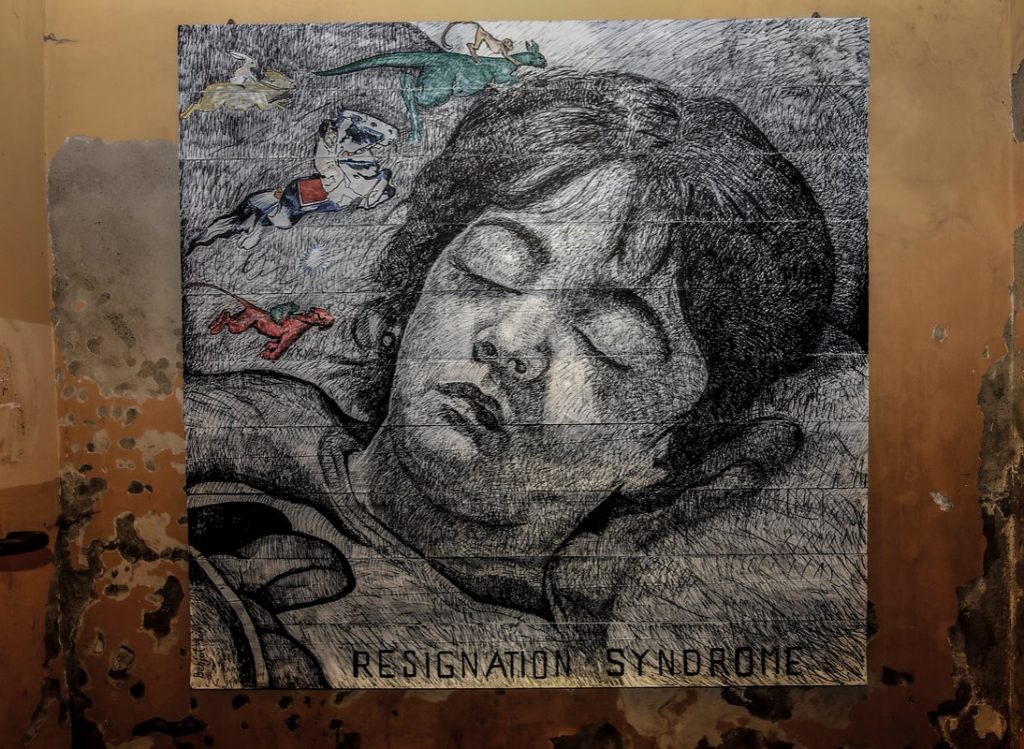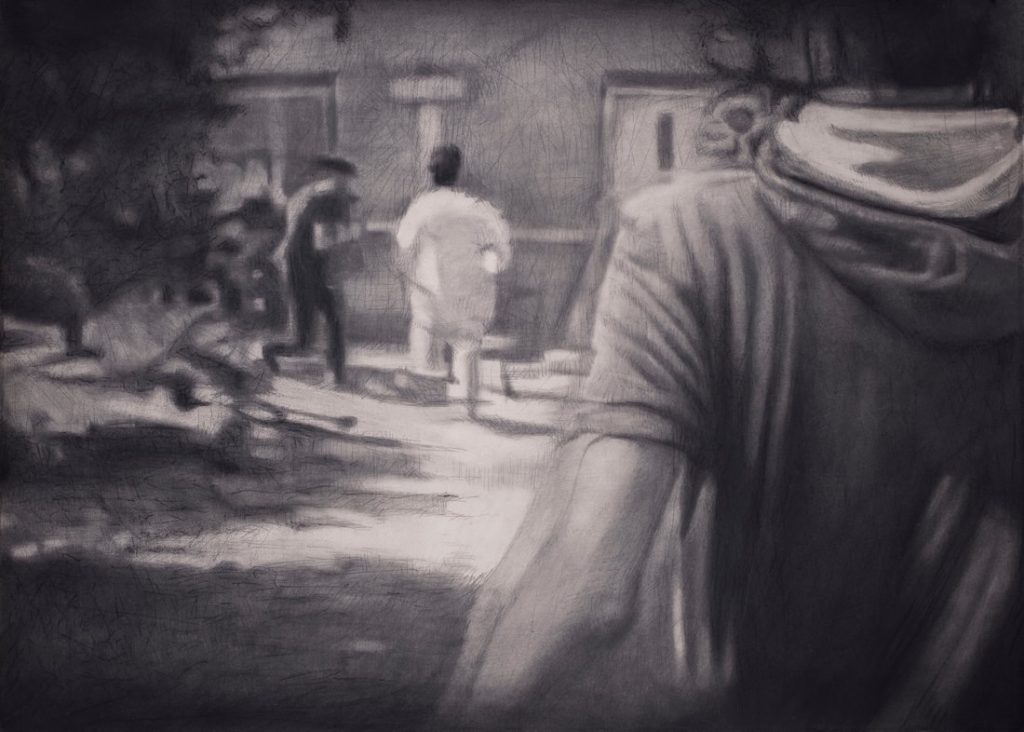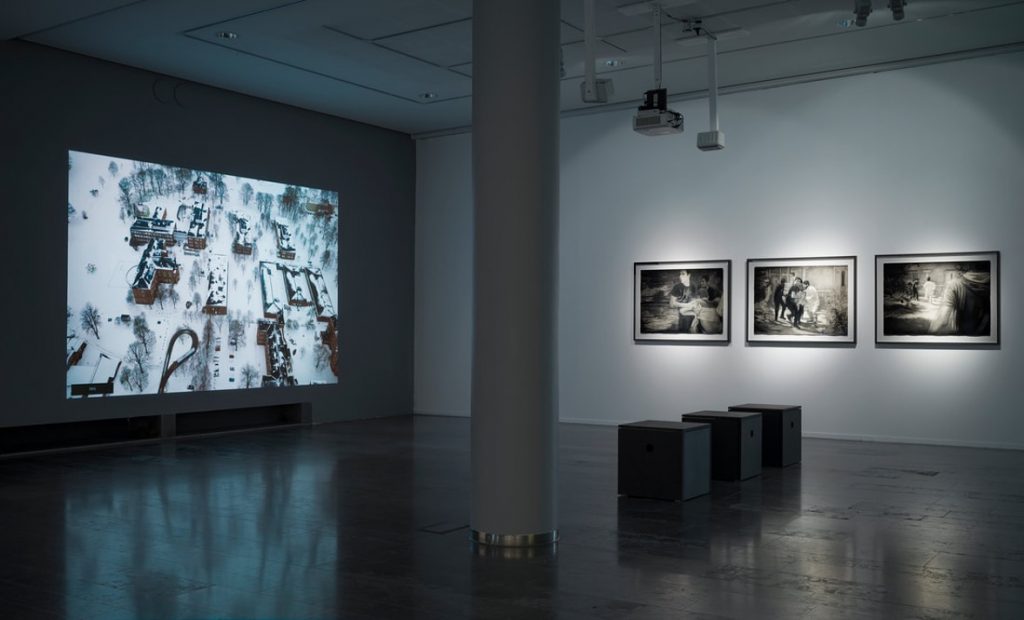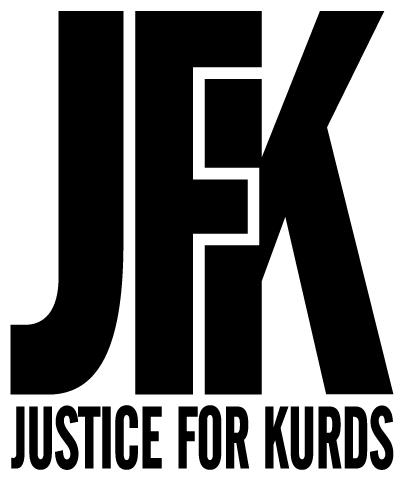Looking at the postcard straight-on, you see a calm sea. The drawing is so realistic that you think it’s a photograph. The waves are small, and a grey light shines onto them; it’s an overcast day. There is nothing else on the water; it is peaceful. Holding the postcard between your fingers, you wonder: “that’s it?”. You put the shiny postcard down, and you start walking away. But then you see something change. Seen from a side angle, a group of six young men – most of them still boys – appears in the middle of the sea. They are standing waist-deep in the water. Their bare chests reach forward towards the viewer, racing towards you. They are unsmiling; they seem cold. You pick the postcard back up, but again, they disappear when the image isn’t at an angle.


Drawings used for postcards, from “From a Distance”, 2016, graphite powder and pencil on paper, 100x150cm.
This lenticular postcard series is an ongoing project of Behjat Omar Abdulla. The Sulaymaniyah-born artist has been living in Sweden for the past eight years. By creating this dual-angled postcard, Abdulla intends to trick the viewer and show something they usually avoid being confronted with: the reality of displacement and the harsh experiences of refugees. Viewers think that they are just looking at an image of a calm sea. Abdulla shatters that expectation and forces viewers to look at the displaced people.
The postcard series is part of Abdulla’s exhibit “From a Distance,” first shown in 2016 at the Göteborgs Art Gallery in Sweden. While the images are beautiful and thought-provoking, it’s the story behind them that Abdulla is most interested in telling. “From a Distance” tells the story of a woman’s journey across the Mediterranean Sea. It is written on the back of the postcard:
“(…) During the harsh physical struggle of the journey, the mother lost one of her twin infants. She kept the dead child with her for days on the boat despite the loss. As tensions rose, the smugglers tried to force the mother to throw the body of her child into the sea. She refused and kept the body with her. One night, while the mother was sleeping, the smugglers took action. The mother woke to realize that her living child was missing and that she had been left with the dead child. The smugglers had mistakenly thrown the sleeping twin into the sea.”
Sharing these shocking stories is a way for Behjat Omar Abdulla to express the powerlessness he feels when confronted by the reality of displacement. For him, art is not simply about creating aesthetic visuals; it is also about raising awareness, showing others, and asking questions about the meaning of identity.
Abdulla was still a student in Fine Art during the Kurdish revolution of 1991 when the dictatorship of Saddam Hussein weighed heavily on Kurdish peoples’ rights in Iraq. He was raised amid war and perpetual bombing, which marked his worldview. Yet, when he studied art at university, he received a Eurocentric theoretical education. This led him to believe art was removed from the reality of life and the violence he experienced day-to-day. Upon graduating, Abdulla questioned his identity and desire to be an artist. For five years, he didn’t create any work. In the meantime, the difficult conditions of life in Iraq forced him to leave, and he embarked on an arduous journey towards Europe.
Art doesn’t only help Abdulla tell the stories of others; it has also enabled him to express and deal with his own experiences as a refugee. Sometimes, his art quite literally saved him. While held captive in a Turkish prison, he avoided deportation by drawing portraits of the prison guards in exchange for food.
After arriving in the UK and completing a BA in Fine Arts, Abdulla began making his art career a priority and exhibiting his work in different galleries across Europe. Each piece of art he creates builds on previous ones: his body of work represents his experiences and the stories of refugees.

Installation view, Behjat Omer Abdulla, Resignation Syndrome 2019, drawing ink and acrylic on wood, 200 x 200 cm. Location: Dronningens gate 27, 0154 Oslo, Norway.
Abdulla’s work also tried to raise awareness of little-known issues, such as the “Resignation Syndrome”. By simply writing these words on the drawing of a young girl sleeping, he invites the viewer to question the title and to discover more about the syndrome that affects the children of refugees when they sense their parents’ fear of deportation.
Behjat Omar Abdulla’s work is powerful. Rooted in personal experience and empathy, Abdulla tells compelling stories through his visual art. Using original formats, he pushes the viewer beyond a passive response. Seeing Abdulla’s art is not only humbling, but it also forces the viewer to recognize realities that are often unacknowledged.
To find out more about Behjat Omar Abdulla and his work, you can visit his website: https://www.behjatomer.com/
There, you will find more of Behjat Omar Abdulla’s work, including “It’s Your Turn Doctor”, which was exhibited at the Hasselblad Gallery in 2018. This series of drawings tell the story of Mohammad, a young man Abdulla met that survived an aerial bombing in May 2013 in the city of Daraa.

Daraa Shelling I (It’s your turn doctor) Drawing, Graphite powder, pencil and ink on paper. 105 cm x 75 cm _2018

Installation view, Hasselblad Gallery, Gothenburg 2018. Photo by Cecilia Sandblom
We recommend taking a look at Behjat Omer Abdulla’s work.
Thank you for sharing your art, and your story with us, Behjat.
